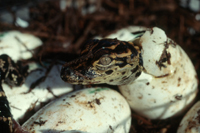
Alligator eggs hatchingThe development of bone structures in alligator eggs raised under varying oxygen concentrations creates a link to fossil records of the evolution of vertebrates and prehistoric atmospheric oxygen concentrations, according to a paper to be presented at the Earth System Processes 2 meeting in Alberta, Canada.
"Alligator eggs are an ideal self-contained unit for studying the effects of oxygen on development – they have a limited food source in the yolk and they are incubated in their nesting material at a constant temperature of 89°F and 100 percent relative humidity," said John Vanden Brooks, a graduate student in the Department of Geology and Geophysics at Yale University. He noted that large-scale changes in atmospheric partial oxygen pressure would have had wide-ranging effects on vertebrate evolution and development throughout geologic time.
Understanding the environment's effect on vertebrate evolution and development is essential to the study of ecology, paleontology and evolutionary theory. Oxygen is the most important component in the atmosphere for all vertebrate animals, and while the rise in oxygen level during the Precambrian era has been widely studied, little attention has previously been paid to continued fluctuations throughout the Phanerozoic.
His mentor, Robert A. Berner, the Alan M. Bateman Professor of Geology and Geophysics at Yale, characterized the range of atmospheric oxygen levels over multimillion year times scales, and established an upper value of about 31 percent oxygen, and a sharp decline near the Permo-Triassic boundary to about 12 percent. Earth's current atmosphere is about 21 percent oxygen.
"Each clutch contains 30 – 50 eggs that are laid together, so easy comparison can be made between sibling eggs raised under different partial pressures of oxygen," said Vanden Brooks. Studying five different partial oxygen pressures across this broad range, he found an optimum at 27 percent oxygen. He found that both high and low oxygen levels altered growth patterns and affected the timing and extent of bone development, its chemical composition, and mortality of the developing eggs.
While it is well known that oxygen balance is important in human premature infant development, this work provides an important step in understanding the complex interaction between vertebrate development and oxygen levels.
The talk, "Phanerozoic Oxygen Levels and their Effect on Modern Vertebrate Development" will be presented at the meeting August 8 – 11 that is co-sponsored by the Geological Society of America and the Geological Association of Canada. Eggs were made available by Ruth Elsey of the Rockefeller Wildlife Refuge in Louisiana. The study was funded by the Geological Society of America, the Paleontological Society, the American Museum of Natural History, the American Philosophical Society, the National Science Foundation, Yale Institute for Biospheric Studies, and the Ecology and Systematics of Animals on the Verge of Extinction Fund.
Source : Yale University
 Print Article
Print Article Mail to a Friend
Mail to a Friend
